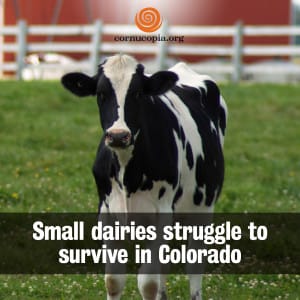In Weld County, larger producers have an edge

The Durango Herald
by Eric Brown
GREELEY (AP) – The cattle at Gege Ellzey’s family dairy are said to be part of a bloodline that can be traced back to the livestock that hauled her ancestors West in covered wagons.
Those are things she tries not to think about as she sees the animals leave the property to go to other milking operations, which she’s had to do in recent weeks after the family decided to stop fighting the many challenges of running a small dairy and closed it.
The general claim that there’s limited opportunity for small producers in agriculture has been proved wrong in many ways in Weld County, but it certainly holds water – or milk – when it comes to one of the largest contributors to the local ag economy.
Because of the unique challenges of the dairy business, the landscape of the industry as a whole has changed dramatically over the years, with fewer and fewer operations handling more and more of the milk production.
And many of the smaller players – like Ellzey and others – have lost their place along the way.
When the most recent comprehensive U.S. Census of Agriculture was released in 2007, it showed that from 1987 to 2007, the number of farms and beef-cattle operations in Weld County had actually increased, and the average size of the operations had shrunk.
But dairies in Weld County – a top-20 milk producer nationally, and the state’s leader – had fallen in numbers from 278 to 97, while the average size of the dairy during that time increased more than four-fold, going from 136.9 cows per operation to 719.4.
Up-to-date numbers are limited. The 2013 Colorado Agricultural Statistics publication doesn’t include a breakdown by county of the number of dairies or average herd size, and the next U.S. Census of Agriculture – based on 2012 figures – won’t be released until next year.
But local milk producers aren’t expecting new numbers to reflect any reversal of dairy consolidation.
Narrow profit margins
Locally, an exacerbation of the trend is more likely, many say, with population growth in northern Colorado straining resources – increasing the demand and price for land and water.
Also, new 2,000-plus-head dairies are moving into the area from out of state and larger existing dairies are expanding to meet the needs of a growing Leprino Foods cheese-processing plant in Greeley. That ongoing dairy growth is a major factor in Leprino’s anticipated economic impact, which through 20 years is expected to be about $15 billion.
But that increased competition for water, land, feed and workers has made it more expensive for all dairies to operate, and the narrow profit margins are especially tough on small producers.
“In the dairy business, you have so many inputs … labor, a lot of water, a lot of feed, a lot of electricity, which is all getting more expensive … while you have so little control over the price you get for the milk you produce,” said Ellzey, whose 200-milking cow dairy had been operating near Galeton for decades. “Those dynamics have pushed a lot of smaller producers out of business. And it’s not getting any better.
“With such narrow profit margins per cow, if you don’t have thousands of cows, it’s so tough to make it anymore.”
Rising costs
Typically, livestock feed accounts for about 40 to 50 percent of a dairy’s operating expenses and, from 2007 to about 2012, the price of corn – a major component of livestock feed rations – doubled because of increased demand and drought. The price of hay also doubled in recent years, thanks to the widespread dry spells of 2011 and 2012.
During that time, though, the price dairymen received for their milk didn’t see such increases.
The average price dairymen received for their milk in Colorado in 2007 was $19.30 per hundredweight, according to the National Agricultural Statistics Service’s Colorado office.
In 2012, the average price Colorado dairymen received for milk was actually lower, at $18.60 per hundredweight.
Charles Tucker, who operates a dairy near Pierce with about 400 milking cows, said that with such challenges in place, if the right buyer offers him the right price, he’s selling the dairy.
“We keep being told, ‘You need to be more efficient.’ But we’re already doing everything we can,” said Tucker, whose family started the dairy in 1966. “And efficiency can only go so far when your feed costs double and the price of water doubles, and the price you get for your milk doesn’t change.”
The advantage of size
Larger dairies, Tucker and Ellzey explained, have the resources to advance purchase large supplies of feed, helping them lock in lower prices, which makes a big difference.
Larger dairies often have the land, machinery and other resources to grow a sizeable portion of their own feed.
Larger dairies also get more production out of their facilities and can take better advantage of other fixed costs in place, such as getting more cows through the milking parlor each day, they added.
“That’s how it has to be done now,” Ellzey said.
Many smaller dairies are faced with the choice of either expanding to become more efficient – which, with the increasing costs for everything needed to grow, requires a huge capital investment, possibly hundreds of thousands of dollars – or closing up shop.

